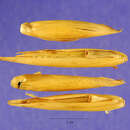Comments
provided by eFloras
The determination of Chinese gatherings as this species is doubtful.
The culms are used for scaffolding.
- license
- cc-by-nc-sa-3.0
- copyright
- Missouri Botanical Garden, 4344 Shaw Boulevard, St. Louis, MO, 63110 USA
Description
provided by eFloras
Culms 8–12 m, 4–5 cm in diam., basally slightly flexuose, apically erect or slightly drooping; internodes ca. 30 cm, initially thinly white powdery, glabrous, lower ones with yellow-green or pale green stripes; wall thick; nodes flat, lower ones with a ring of gray-white silky hairs below and above sheath scar, basal 1 or 2 nodes with short aerial roots; branching from 3rd or 4th node up. Branches several to many per node with central dominant. Culm sheaths deciduous, leathery, ribbed-striate when dry, glabrous, margins densely ciliate, apex slightly asymmetrical, broadly arched; auricles unequal, undulate, wrinkled; larger auricle slightly slanted downward for 1/7–1/6 of sheath, oblong, 2.5–3 × ca. 1 cm, ends subrounded; smaller auricle suborbicular, ca. 1/2 size of larger; oral setae slender, undulate, densely covering margins of auricles; ligule 4–5 mm, margin irregular, finely dentate and laciniate, densely ciliolate; blade erect, slightly asymmetrical, ovate-triangular, base slightly rounded, then extending outward and joined with auricles for 4–5 mm, base nearly 2/3 as wide as sheath apex. Leaf blade linear or linear-lanceolate, 9–15 × 1–1.5 cm, abaxially densely pubescent, adaxially glabrous. Inflorescence not known from China.
- license
- cc-by-nc-sa-3.0
- copyright
- Missouri Botanical Garden, 4344 Shaw Boulevard, St. Louis, MO, 63110 USA
Habitat & Distribution
provided by eFloras
Cultivated. Guangdong [native to Bangladesh and Myanmar].
- license
- cc-by-nc-sa-3.0
- copyright
- Missouri Botanical Garden, 4344 Shaw Boulevard, St. Louis, MO, 63110 USA
Bambusa longispiculata: Brief Summary
provided by wikipedia EN
Bambusa longispiculata, or Mahal bamboo, is a species of clumping bamboo native to Bangladesh and Myanmar, but widely grown in many other countries including Australia. Growing in wide and open clumps, it makes an excellent shelter for waterfowl. It is not suited for harvesting and is very suitable for soil stabilization on dam faces. It can grow up to a height of 10 m, and a thickness of 5 cm.
- license
- cc-by-sa-3.0
- copyright
- Wikipedia authors and editors

